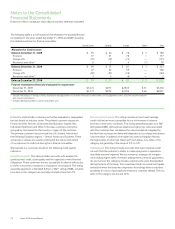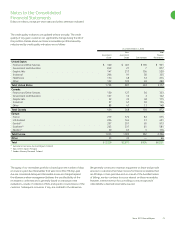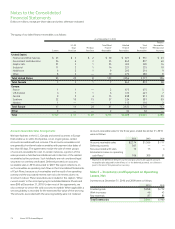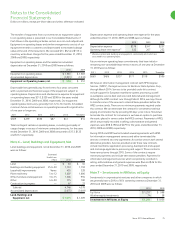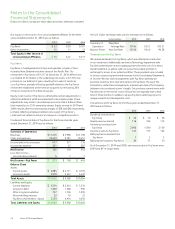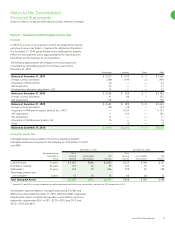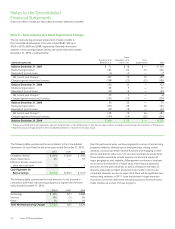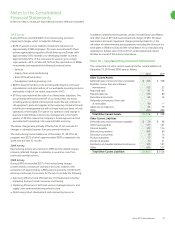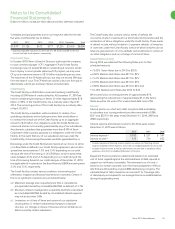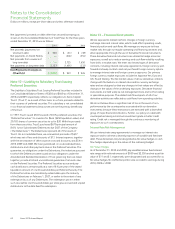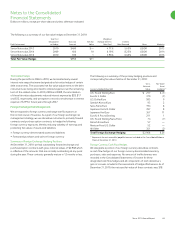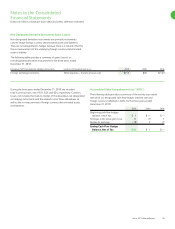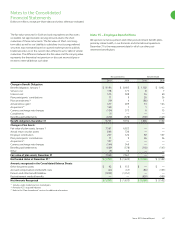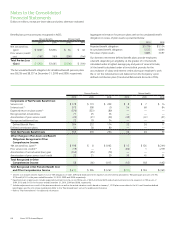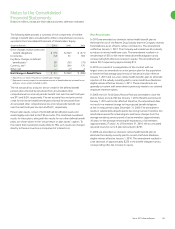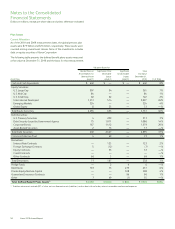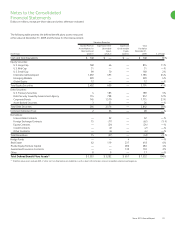Xerox 2010 Annual Report Download - page 84
Download and view the complete annual report
Please find page 84 of the 2010 Xerox annual report below. You can navigate through the pages in the report by either clicking on the pages listed below, or by using the keyword search tool below to find specific information within the annual report.
Notes to the Consolidated
Financial Statements
Dollars in millions, except per-share data and unless otherwise indicated.
82 Xerox 2010 Annual Report
Note 13 – Financial Instruments
We are exposed to market risk from changes in foreign currency
exchange rates and interest rates, which could affect operating results,
financial position and cash flows. We manage our exposure to these
market risks through our regular operating and financing activities and,
when appropriate, through the use of derivative financial instruments.
These derivative financial instruments are utilized to hedge economic
exposures, as well as to reduce earnings and cash flow volatility resulting
from shifts in market rates. We enter into limited types of derivative
contracts, including interest rate swap agreements, foreign currency spot,
forward and swap contracts and net purchased foreign currency options
to manage interest rate and foreign currency exposures. Our primary
foreign currency market exposures include the Japanese Yen, Euro and
U.K. Pound Sterling. The fair market values of all our derivative contracts
change with fluctuations in interest rates and/or currency exchange
rates and are designed so that any changes in their values are offset by
changes in the values of the underlying exposures. Derivative financial
instruments are held solely as risk management tools and not for trading
or speculative purposes. The related cash flow impacts of all of our
derivative activities are reflected as cash flows from operating activities.
We do not believe there is significant risk of loss in the event of non-
performance by the counterparties associated with our derivative
instruments because these transactions are executed with a diversified
group of major financial institutions. Further, our policy is to deal with
counterparties having a minimum investment grade or better credit
rating. Credit risk is managed through the continuous monitoring of
exposures to such counterparties.
Interest Rate Risk Management
We use interest rate swap agreements to manage our interest rate
exposure and to achieve a desired proportion of variable and fixed rate
debt. These derivatives may be designated as fair value hedges or cash
flow hedges depending on the nature of the risk being hedged.
Fair Value Hedges
As of December 31, 2010 and 2009, pay variable/receive fixed interest
rate swaps with notional amounts of $950 and $2,350 and net asset fair
value of $11 and $1, respectively, were designated and accounted for as
fair value hedges. No ineffective portion was recorded to earnings during
2010, 2009 or 2008.
Net (payments) proceeds on debt other than secured borrowings as
shown on the Consolidated Statements of Cash Flows for the three years
ended December 31, 2010 was as follows:
2010 2009 2008
Net proceeds (payments) on
short-term debt $ 300 $ (61) $ (38)
Net payments on Credit Facility — (246) (354)
Net proceeds from issuance of
long-term debt — 2,725 1,650
Net payments on long-term debt (3,357) (1,495) (332)
Net (Payments) Proceeds on
Other Debt $ (3,057) $ 923 $ 926
Note 12 – Liability to Subsidiary Trust Issuing
Preferred Securities
The Liability to Subsidiary Trust Issuing Preferred Securities included in
our Consolidated Balance Sheets of $650 and $649 as of December 31,
2010 and 2009, respectively, reflects our obligations to Xerox Capital
Trust I (“Trust I”) as a result of their loans to us from proceeds related to
their issuance of preferred securities. This subsidiary is not consolidated
in our financial statements because we are not the primary beneficiary
of the trust.
In 1997, Trust I issued 650 thousand of 8.0% preferred securities (the
“Preferred Securities”) to investors for $644 ($650 liquidation value) and
20,103 shares of common securities to us for $20. With the proceeds
from these securities, Trust I purchased $670 principal amount of
8.0% Junior Subordinated Debentures due 2027 of the Company
(“the Debentures”). The Debentures represent all of the assets of
Trust I. On a consolidated basis, we received net proceeds of $637
which was net of fees and discounts of $13. Interest expense, together
with the amortization of debt issuance costs and discounts, was $54 in
2010, 2009 and 2008. We have guaranteed, on a subordinated basis,
distributions and other payments due on the Preferred Securities. The
guarantee, our obligations under the Debentures, the indenture pursuant
to which the Debentures were issued and our obligations under the
Amended and Restated Declaration of Trust governing the trust, taken
together, provide a full and unconditional guarantee of amounts due
on the Preferred Securities. The Preferred Securities accrue and pay
cash distributions semiannually at a rate of 8% per year of the stated
liquidation amount of one thousand dollars per Preferred Security. The
Preferred Securities are mandatorily redeemable upon the maturity
of the Debentures on February 1, 2027, or earlier to the extent of any
redemption by us of any Debentures. The redemption price in either
such case will be one thousand dollars per share plus accrued and unpaid
distributions to the date fixed for redemption.


